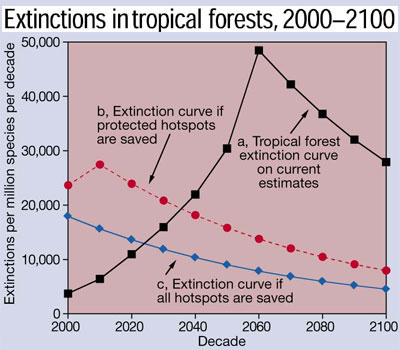
|
|
The 25 biodiversity hotspots, 17 of them tropical, have already suffered disproportionate loss of primary vegetation, meaning that the many species they contain are under particular threat of extinction. Even if all remaining habitats in hotspots are saved (as shown in curve c), some 18 percent of their species will still be lost. The same half-life for currently threatened species is used as in curve a. However, if the hotspots are cleared in the next decade to the point where only currently protected areas are saved (curve b) then the total extinctions will be higher.
|
It doesn't take a close encounter with a comet to wipe out 40 percent of the species on earth. Chainsaws and bulldozers can do the job just as well.
Humanity's destruction of tropical habitat for agriculture, logging and other development has inflated earth's normal background extinction rate by as much as 1,000 times, said Stuart Pimm, a senior research scientist at Columbia's Center for Environmental Research and Conservation.
"This constitutes by far and away our greatest impact on the planet, both today and for millions of years to come," Pimm said. "Species extinction is irreversible. Jurassic Park is just a movie."
In an article published in the February 24 issue of Nature entitled "Extinction by numbers," Pimm and co-author Peter Raven of the Missouri Botanical Garden examine the potential extinction scenarios for the 21st Century. The outlook they present is sobering.
Of an estimated 7 million plant and animal species on earth, about 85 percent live on land with about two-thirds of them in the tropics, mostly the rainforests. Prior to modern human influence, these forests covered approximately 16 million square kilometers. Today about 8 million remain. The current rate of forest loss is about 1 million square kilometers every 5 to 10 years and accelerating, with several times that area being damaged by fires and selective logging.
At this pace, the tropical forests will be gone well before the end of the century, along with over half of all earth's species. And on closer inspection, the picture only gets worse.
It turns out that 30 to 50 percent of all plant, amphibian, reptile, bird and mammal species are found in just 25 biodiversity "hotspots" that comprise less than 2 percent of earth's ice-free land surface. Seventeen of these hotspots are tropical forest areas where only 12 percent of the original habitat remains. Pimm's analysis indicates that about one-fifth of the species in these 17 areas are either already gone, or on the verge of extinction. Barring immediate action, within 10 years only those areas already protected from development will remain, with about 40 percent of the species lost forever.
Luckily the numbers also reveal a ray of hope, if only we heed the warning, Pimm said.
The relationship between habitat loss and extinction is nonlinear. Initial destruction of a habitat squeezes most tenant species into shrinking remnants of their original territory, driving to extinction only those whose highly restricted ranges are entirely consumed. Eventually though, as the remaining habitat shrinks to a small fraction of its former size, the rate of extinction accelerates rapidly and peaks before dwindling off as the final surviving species succumb.
While that sounds grim, it also means that the actual extinction impact of tropical habitat loss thus far has been relatively minor. Although the rainforests are already half gone, about 85 percent of their species remain. Thus, strong conservation steps taken now could greatly reduce the tropical forest extinction rate, which otherwise will peak at losing nearly 50,000 species per million species every decade by mid-century, Pimm said.
Moreover, by focusing our immediate conservation efforts on the hotspot areas at greatest risk, we can achieve an enormous improvement in the extinction outlook very quickly, even though broad scale conservation will still be necessary to preserve long-term biodiversity, Pimm said.
The last great global extinction happened about 65 million years ago when about 40 percent of all the species on earth, including the dinosaurs, were wiped out. A widely held theory attributes that event to a catastrophic comet impact, which clogged the atmosphere with dust that blotted out the sun.
It took about 10 million years for the planet to recover from that loss of biodiversity, although the assemblage of species, of course, ended up very different, Pimm said.
"Our actions today, for better or worse, will continue to impact the earth for millions of years to come," Pimm said. "Unless we take immediate and efficient steps to curb the rate of tropical habitat loss, particularly in the hotspot areas, scientists 10 million years hence will view the 21st century as we do the end of the Cretaceous -- as a major extinction catastrophe."
|
